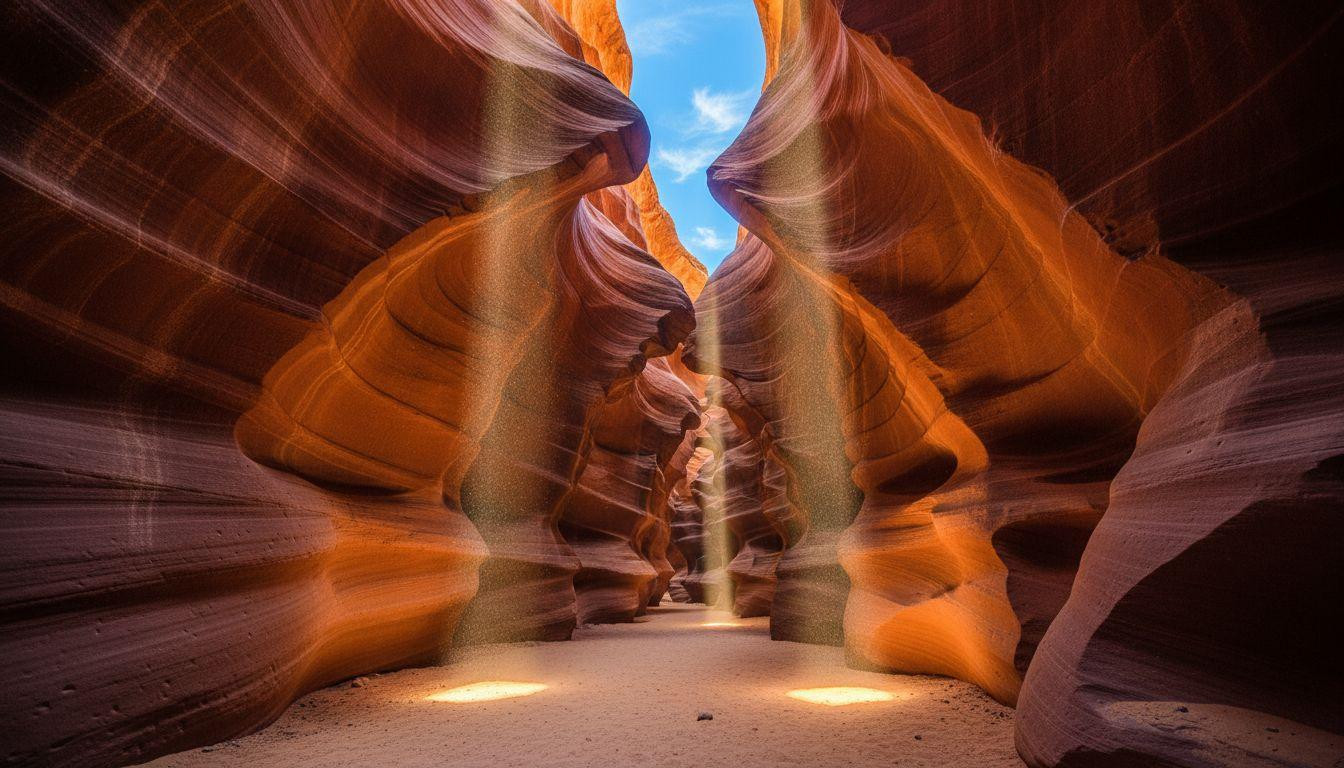Light pierces the narrow opening above, illuminating dust particles in vertical columns that seem to suspend time itself. This is Antelope Canyon, where Navajo Sandstone walls curve in impossible waves 120 feet overhead, accessible only through guided tours that blend geological wonder with cultural reverence. The slot canyon near Page, Arizona transforms every visitor into both photographer and pilgrim, experiencing one of Earth’s most dramatic collaborations between water, wind, and sacred indigenous land.
Entering the slot
The journey begins in Page, a high desert town of 7,000 residents serving as gateway to this geological marvel. Tour operators require advance booking, with Navajo Nation guides mandatory for all canyon access. Upper Antelope Canyon tours start at $85-159 per person, while Lower Canyon visits range from $73-105 plus an $8 Navajo permit fee.
The slot itself defies easy description. Upper Canyon passages narrow to just 4 feet wide in sections, creating intimate corridors where sandstone walls rise vertically toward thin strips of sky. Horseshoe Bend’s dramatic Colorado River curve just 7 miles from Page offers a complementary perspective on the region’s carved landscape, but Antelope Canyon’s confined spaces create an entirely different emotional experience.
Lower Antelope Canyon requires descending approximately 100 feet via metal staircases, entering a wider slot featuring wave-like formations. The seasonal wash status means both canyons remain active drainage channels, shaped by flash floods that carved these passages over millennia of patient erosion.
Light beams and sacred space
When physics meets geology
The famous light beams appear when sun angles align perfectly with canyon openings, typically during late spring through early summer. Peak visibility occurs between 10am-2pm when dust particles suspended in still air become illuminated columns reaching the sandy floor below. These “god rays” transform photography sessions into almost spiritual encounters with natural light behavior.
November visits offer different rewards. Cooler temperatures make the physical navigation more comfortable, while lower sun angles create subtle lighting effects that reveal the sandstone’s layered geological history in burnt orange, terracotta, and cream tones.
Navajo cultural significance
Every canyon tour includes cultural interpretation from Navajo Nation guides who share creation stories and explain the site’s sacred dimensions. The Lower Canyon’s Navajo name, Hasdeztwazi, means “Spiral Rock Arches,” reflecting indigenous perspectives on these formations that predate tourism by thousands of years.
Tour guides emphasize treating the canyon with reverence befitting a sacred site. Monument Valley’s Navajo sandstone formations 120 miles southeast share similar cultural significance, but Antelope Canyon’s mandatory guide system ensures every visitor receives direct cultural education.
The guided experience
Upper canyon tours
Upper Antelope Canyon tours last 90 minutes total, including 15-minute shuttle rides to the entrance. Groups are limited to 15 people maximum for safety and experience quality. Photography tours command premium pricing from $200-400, offering extended time and tripod permissions typically restricted on standard visits.
The Navajo Tours operation, established by the Navajo Nation, offers multiple daily departures: 7:30am, 9:35am, 11:40am, 1:45pm, and 3:50pm. Peak season booking requires reservations 1-2 months in advance, with same-day availability virtually impossible during summer months.
Lower canyon alternative
Lower Canyon visits emphasize wave formations over light beams, featuring smooth undulating walls that create abstract patterns ideal for photography. The staircase descent requires moderate physical ability but rewards visitors with wider passages allowing more movement during tours.
Iceland’s Stuðlagil Canyon where basalt columns create similar slot canyon photography offers international comparison, but Antelope Canyon’s accessibility and established infrastructure make it uniquely visitor-friendly among world-class slot canyons.
Beyond the slot
The 1997 flash flood that claimed 11 lives in Lower Antelope Canyon transformed safety protocols for slot canyon tourism nationwide. Current weather monitoring and mandatory guide requirements reflect hard-learned lessons about respecting these active geological systems.
Page serves as an ideal base for canyon exploration, with hotels ranging from $80-250 nightly depending on season and amenities. Restaurant options reflect standard American fare with some Mexican influences, though dining variety remains limited in this small high desert community.
November 2025 offers optimal timing for visits: comfortable temperatures averaging 55°F highs and 30°F lows, reduced crowds compared to summer peak season, and excellent photography conditions without intense heat. New Zealand’s Waitomo Caves where guided tours access glowworm displays in limestone caves share the guided access requirement, but Antelope Canyon’s cultural component adds layers of meaning beyond pure natural spectacle.
Your questions about Antelope Canyon answered
Do I need to book ahead?
Peak season (June-August) requires booking 1-2 months in advance, with tour operators releasing slots gradually. November offers more flexibility, though Thanksgiving week (November 24-28, 2025) typically fills early. Standard gratuity of $3-5 per person in cash for Navajo guides is expected beyond tour fees.
Which canyon should I choose?
Upper Antelope Canyon delivers the famous light beam photography during optimal seasons, while Lower Canyon emphasizes wave formations and requires more physical navigation via staircases. Both offer profound geological drama, with Upper Canyon generally more accessible for mobility-limited visitors.
How does this compare to other slot canyons?
Antelope Canyon provides North America’s most accessible slot canyon experience, contrasting with technical options like Zion’s Narrows requiring hiking and water navigation. The established infrastructure and safety protocols create a trade-off: reduced wilderness solitude for reliable access and cultural education that most remote slot canyons cannot offer.
The last light fades from the canyon opening above as our group emerges, carrying images of carved sandstone curves that no camera fully captures. The silence of the slot lingers, a reminder that some of Earth’s most powerful artistry happens in spaces barely wide enough for human passage.
